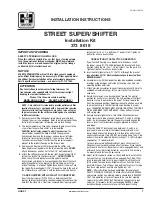
216
Vehicle care
means your vehicle has been sitting
for at least three hours or driven no
more than one mile.
Notice
Do not let anyone tell you that un‐
derinflation or overinflation is all
right. It is not. Too little air in your
tires (underinflation) could result in
the following:
■ Too much flexing.
■ Too much heat.
■ Tire overloading.
■ Poor wear.
■ Poor handling.
■ Poor fuel economy.
Too much air in your tires (overinfla‐
tion) could result in the following:
■ Unusual wear.
■ Poor handling.
■ Rough ride.
■ Needless damage from road haz‐
ards.
Adjust the tire pressure to match the
current load and speed of the car. The
stating tire pressures apply to cold
tires, i.e. tires that are the same tem‐
perature as the outside air tempera‐
ture. Tire pressure increases as the
tires become warm (e.g. during high‐
way driving) by approximately 4 psi.
When the temperature of the tires
changes by 50 °F, the tire pressure
will change 2 psi.
Never reduce the pressure of a hot
tire. If the tires are hot when you
check them, only increase the pres‐
sure if necessary.
Tire Pressure Monitoring
System
The tire pressure monitor system
(TPMS) uses radio and sensor tech‐
nology to check tire pressure levels.
The TPMS sensors monitor the air
pressure in your vehicle's tires and
transmit tire pressure readings to
a receiver located in the vehicle.
Each tire, including the spare (if pro‐
vided), should be checked monthly
when cold and inflated to the inflation
pressure recommended by the vehi‐
cle manufacturer on the vehicle plac‐
ard or tire inflation pressure label. (If
your vehicle has tires of a different
size than the size indicated on the ve‐
hicle placard or tire inflation pressure
label, you should determine the
proper tire inflation pressure for those
tires).
As an added safety feature, your ve‐
hicle has been equipped with a TPMS
that illuminates a low tire pressure
telltale when one or more of your tires
is significantly under-inflated.
Accordingly, when the low tire pres‐
sure telltale illuminates, you should
stop and check your tires as soon as
possible, and inflate them to the
proper pressure. Driving on a signifi‐
cantly under-inflated tire causes the
tire to overheat and can lead to tire
failure. Under-inflation also reduces
fuel efficiency and tire tread life, and
may affect the vehicle's handling and
stopping ability.
Please note that the TPMS is not
a substitute for proper tire mainte‐
nance, and it is the driver's responsi‐
bility to maintain correct tire pressure,
even if under-inflation has not
Содержание 9-5 2011
Страница 1: ......
Страница 3: ...2 Introduction Introduction ...
Страница 8: ...Introduction 7 ...
Страница 12: ...In brief 11 ...
Страница 102: ...Instruments and controls 101 Control indicators in the instrument cluster ...
Страница 185: ...184 Vehicle care Engine compartment overview Gasoline engine 2 0 Turbo ...
Страница 186: ...Vehicle care 185 Gasoline engine 2 8 Turbo ...
Страница 259: ...258 Drive Swedish ...
















































